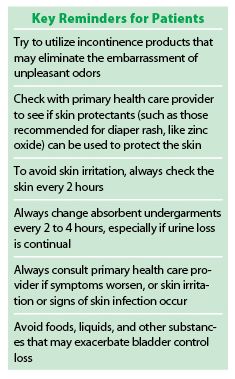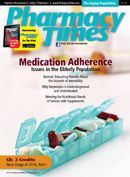Overactive Bladder Concerns: Urinary Incontinence Supplies
Urinary incontinence can often be improved or cured. Many patients do not seek help, so the problem is left untreated. Here is how the pharmacist can help.
Urinary incontinence can often be improved or cured. Many patients do not seek help, so the problem is left untreated. Here is how the pharmacist can help.
Urinary incontinence (UI) affects many individuals of all ages. Although the rates of incontinence increase over the age of 65, it is not a normal part of the aging process. Urinary incontinence is a symptom that can be the result of various causes which include anatomic, physiologic, and pathologic factors affecting the urinary tract.1
The condition is widely underdiagnosed and underreported. An estimated 25 million individuals in the United States experience transient or chronic UI; 85% of these cases affect women; 9 to 13 million of these women experience bothersome and severe symptoms which negatively impact their overall quality of life.2-4 In addition, another 34 million individuals, or 1 in 5 adults over the age of 40, are affected by various degrees of overactive bladder or experience recurring symptoms of urgency and frequency.4 Worldwide, UI affects 200 million individuals. 3,4 According to the National Association for Continence (NAC), approximately 80% of those with urinary incontinence can be cured or improved.4 However, more than 50% of individuals affected by bladder disorders rarely if ever discuss these issues with their primary health care provider because of embarrassment and possibly denial, so the problems are left untreated.2 According to the NAC, on average, women wait at least 6.5 years from the first time they experience UI symptoms until they seek medical care and get a diagnosis for their bladder control issues; at least two thirds of those who experience bladder control symptoms do not use any treatment or product to manage their UI.3

Many factors can contribute to UI. Some cases of urinary incontinence may be transient and caused by the use of certain medications or by a urinary tract infection, and can be reversed.5 Many UI cases can become chronic and longlasting unless the individual seeks medical evaluation and treatment.5,6 In general, the 3 main types of treatment for urinary incontinence include behavioral techniques, use of pharmacologic agents, and surgery.2,4,6 For individuals whose UI cannot be cured or for those who are awaiting treatment, various devices or products are available from the pharmacy to aid in the management of UI, including catheters, pelvic organ support devices, urethral inserts, external collection systems, and absorbent products.1,4
The Role of the Pharmacist
Pharmacists are likely to receive inquiries about supplies for the management of urinary incontinence; therefore, it is important for pharmacists to understand urinary incontinence and be prepared to counsel and guide patients and caregivers in the selection of absorbent products. Pharmacists should always encourage patients to seek advice from their primary health care provider prior to using any of these products and advise them that many cases of UI are reversible with proper treatment.1
Pharmacists can also be key in identifying the various medications which may contribute to or cause urinary incontinence; examples include ACE inhibitors, alpha-adrenergic blockers, antihistamines, calcium channel blockers, diuretics, and antidepressants.1,8-10

A variety of absorbent products are available, including guards/shields and undergarments and briefs, to assist in the absorption of urine. These products come in disposable or reusable form and in a variety of sizes. They may aid in providing a moisture barrier to protect clothes, bedding, and furniture, as well as minimize skin contact with urine. Factors that are often considered in the selection of these products may include the amount of urine that is typically leaked, the severity and type of urinary incontinence, the patient’s functional status, the patient’s personal preference, ease of use, cost, and the product’s ability to control odor.1,11
In addition, there are products designed to meet the individual needs of men and women, as well as products designed for overnight use. There are also a host of disposable cleaning supplies to guard against skin rashes and irritation. Pharmacists can help patients understand that there are many options available for both the treatment and management of urinary incontinence that may enable them to improve their quality of life.
For more information on urinary incontinence and excellent patient education resources, please visit the following Web sites: The National Association for Continence at www.nafc.org/; National Kidney and Urologic Diseases Information Clearinghouse at http://kidney.niddk.nih. gov/kudiseases/topics/incontinenceasp; American Foundation for Urologic Disease at www.afud.org or www.incontinence. org; About Incontinence (Attends Healthcare Products Web site) at www. attends.com/about_incontinence/index. html; and Incontinence Information for Women and Men (Kimberly Clark Depend Product Web site) at http://www. us.depend.com/articles-discussion. PT
References:
1. O’Neil, Christine. Adult urinary incontinence and supplies. In: Berardi R, Newton G, McDermott JH, et al, eds. Handbook of Nonprescription Drugs. 16th ed. Washington, DC: American Pharmacists Association; 2009:947-959.
2. Urinary Incontinence in Men. MedicineNet.com Web site. http://www.medicinenet.com/urinary_incontinence/article.htm. Accessed November 11, 2010.
3. General prevalence of urinary incontinence. National Association for Continence Web site. http://www.nafc.org/media/statistics/prevalence-2/. Accessed November 12, 2010.
4. What is incontinence? National Association for Continence Web site. http://www.nafc.org/bladder-bowel-health/. Accessed November 12, 2010.
5. Urinary incontinence in adults. National Institutes of Health Web site. http://consensus.nih.gov/1988/1988UrinaryIncontinence071html.htm. Accessed November 14, 2010.
6. Incontinence. Attends Healthcare Products Web site. http://www.attends.com/index.htmlIncontinence. Accessed November 14, 2010.
7. Incontinence. Kimberly Clark Web site. http://www.depend.com/learn/female_incont.asp. Accessed November 14, 2010.
8. Urinary incontinence in the elderly: types and causes of urinary incontinence. Medscape Web site. http://www.medscape.com/viewarticle/410843_5. Accessed November 15, 2010.
9. Urinary incontinence. The Merck Manual for Healthcare Professionals Online Edition. http://www.merckmanuals.com/professional/sec17/ch228/ch228b.html. Accessed November 15, 2010.
10. Nadir, N. Urinary incontinence. Medscape Web site. http://emedicine.medscape.com/article/778772-overview. Accessed November 15, 2010.
11. Urinary incontinence products. Medline Plus Web site. Available at http://www.nlm.nih.gov/medlineplus/ency/article/003973.htm. Accessed November 15, 2010.
Ms. Terrie is a clinical pharmacy writer based in Haymarket, Virginia.

